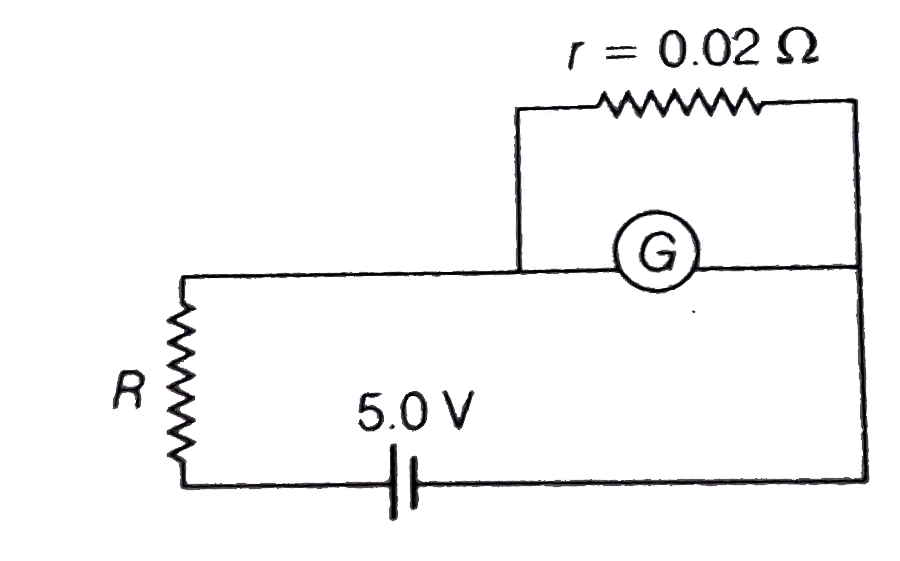A voltmeter of variable ranges 3V, 15V, 150 V is to designed by connecting resistances R1,R2,R3 in series with a galvanometer of resistance G=20Ω, as shown in the figure. The galvanometer gives full pass through its coil. Then, the resistances R1,R2andR3 (in kilo ohms) should be, respectively

3, 12, 135
2.98, 12, 135
2.98, 14.98, 149.98
3.86, 12.55, 122.97
The correct Answer is:B
Step by step video, text & image solution for A voltmeter of variable ranges 3V, 15V, 150 V is to designed by connecting resistances R_(1), R_(2), R_(3) in series with a galvanometer of resistance G=20Omega, as shown in the figure. The galvanometer gives full pass through its coil. Then, the resistances R_(1), R_(2) and R_(3) (in kilo ohms) should be, respectively by Physics experts to help you in doubts & scoring excellent marks in Class 12 exams.
Updated on:21/07/2023Topper's Solved these Questions
Similar Questions
(a) State the principle of working of a galvanometer.
(b) Agalvanometer of resistance G is converted into a voltmeter to measure up to V volts by connecting a resistance R1 , in series with the coil. If a resistance R2 is connected in series with it, then it can measure up to V/2 volts. Find the resistance, in terms of R1andR2, required to be connected to convert it into a voltmeter that can read up to 2 V. Also find the resistance G of the galvanometer in terms of R1 and R2.
View SolutionA galvanometer of resistance G is converted into a voltmenter to measrue upto V volts by connecting a resistance R1 in series with the coil. If a resistance R2 is connected series with it, then it can measure upto 1//2 volts. Find the resistance, in terms of R1 and R2, required to be connected to convert in into a voltmeter that can read upto 2V. Also find the resistance G of the galvanometer in terms of R1 and R2
View Solution
Knowledge Check
An ammeter A, a voltmeter V and a resistance R are connected as shown in the figure. If the voltmeter reading is 1.6V and the ammeter reading is 0.4A, then R is
 Aequal to 4ΩBgreater than 4ΩCless than 4ΩDbetween3Omegaand4Omega
Aequal to 4ΩBgreater than 4ΩCless than 4ΩDbetween3Omegaand4OmegaWhen a resistance of 100Ω is connected in series with a galvanometeer of resistance R, its range is V. To double its range, a resistance of 1000Ω is connected in series. Find R.
A700ΩB800ΩC900ΩD100ΩIn the circuit, shown the galvanometer G of resistance 60Ω is shifted by a resistance r=0.02Ω. The current through R is nearly 1A. The value of resistance R (in ohm) is nearly.
 A1.00ΩB5.00ΩC11.0ΩD6.0Ω
A1.00ΩB5.00ΩC11.0ΩD6.0Ω
State the principle of working of a galvanometer.
A galvanometer of resistance G is converted into a voltmeter to measure upto V volts by connecting resistance R1 in series with the coil. If a resistance R2 is connected in series with it, then it can measure V/2 volts. Find the resistance, in terms of R1 and R2, required to be connected to convert it into a volt meter that can read upto 2 V. Also find the resistance G of the galvanometer in terms of R1 and R2.
View SolutionThe galvanometer shown in the diagram has resistance 100Ω and current required for full-scale deflection is 10mA. Find the resistances R1,R2 and R3 required to convert it into ammeter having ranges as indicated.
 .
.
View Solution(a) State the principle of working of a galvonometer.
(b) A galvonometer of resistance G is converted into a voltmeter to measure upto V volts by connecting a resistance R1 in series with the coil. If a resistance R2 is connected in series with it, then it can measure upto V/2 volts. Find the resistance, in terms of R1andR2, required to be connected to convert it into a voltmeter that can read upto 2 V. Also find the resistance G of the galvanometer in terms of R1andR2 .
View SolutionWith a resistance R connected in series with a galvanometer of resistance 100Ω, it acts as a voltmeter of range 0 to 10 V. To double the range a resistance of 1000 Ω is to be connected in series with R. Then the value of R (∈Ω) is
View SolutionWhen a resistance of 100Ω is connected in series with a galvanometer of resistance R, then its range is V. To double its range, a resistance of 1000Ω is connected in series. Find the value of R.
View Solution
